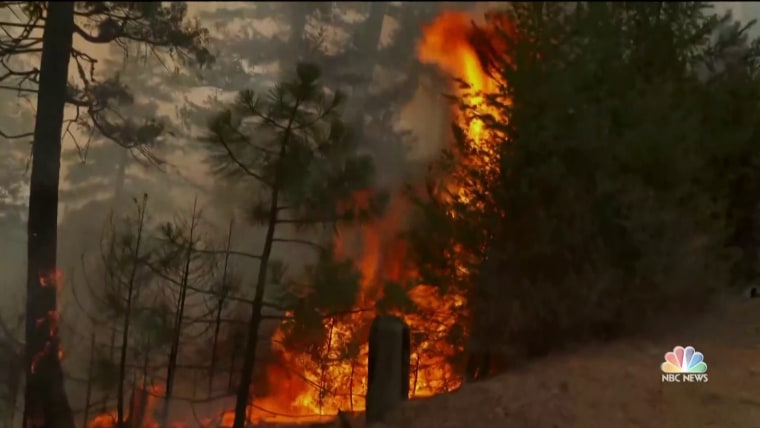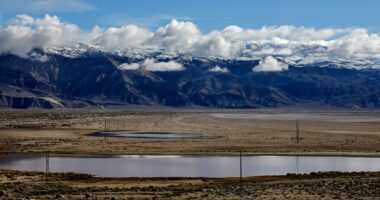The Caldor Fire, which ignited Saturday evening in the Omo Ranch area, about 60 miles east of Sacramento, exploded Tuesday morning from 6,500 acres to 53,772 acres in less than 24 hours by Wednesday morning, according to the California Department of Forestry and Fire Protection, or Cal Fire.
The rapidly expanding wildfire has already seriously injured two people and prompted more mandatory evacuation orders Tuesday evening for thousands of residents and tourists in El Dorado County.
It remains zero percent contained.
Firefighters continue to face dynamic conditions on the ground. Smoke from the nearby Dixie Fire hampered air attack efforts while the shapeshifting nature of the Caldor Fire has made it difficult for officials to accurately map the incident, Cal Fire officials said during a community meeting Tuesday evening.
“We are here to see this until the end,” said Cal Fire incident commander Dusty Martin.
Gov. Gavin Newsom declared a state of emergency for El Dorado County earlier Tuesday, mobilizing the California National Guard and freeing up additional resources for impacted communities.
Two people were airlifted with serious injuries and very few homes were left standing in Grizzly Flats, a town of about 1,200 residents, where streets were littered with downed power lines and poles. Houses were reduced to smoldering ash and twisted metal with only chimneys rising above the ruins. A post office and elementary school were also destroyed.
Residents in Pollock Pines, Sly Park, Happy Valley and the Grizzly Flats and Somerset areas were all issued mandatory evacuation orders while campers were rushed out of the Sly Park Recreation Area. Dark heavy smoke blanketed much of the region, including in nearby Lake Tahoe and other population destinations, prompting bumper-to-bumper traffic along evacuation routes.
Nearly 17,000 people across California are under evacuation orders, according to the California Governor’s Office of Emergency Services, or Cal OES.
Scott Stephens, a professor of wildfire science at the University of California-Berkeley, previously told NBC News that the explosion of wildfires in the past decade has been fueled by the culmination of drought conditions, hotter temperatures and flammable forest debris, like downed trees.
These conditions, he said, are exacerbated by climate change.
“The wildfire growth in the last 10 to 15 years has really exceeded what we would have considered previously, and we’re seeing these fires grow larger and larger and more continuous,” he said.
The ongoing threat of the Dixie Fire, the largest burning blaze in the U.S. and the second-largest in California history, expanded to more than 620,000 acres Wednesday morning. The fire remained 31 percent contained.
Meanwhile, the Monument Fire, northwest of the Dixie Fire, scorched nearly 130,000 acres in Trinity County and was only 10 percent contained, prompting more evacuations in the area Tuesday evening.
Pacific Gas and Electric, the state’s largest utility, shut off power for more than 51,000 customers across 18 counties in California to prevent more wildfires on Tuesday evening, according to the utility. Power is expected to be restored Wednesday after severe weather conditions are cleared, the company said.
Stephens said there was still hope to prevent wildfires from exploding in size.
“We have to do much more forest restoration work, like burning small, controlled fires,” he said. “If we don’t change, we are never going to chase this problem down.”
Source: | This article originally belongs to Nbcnews.com










